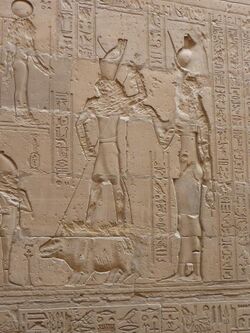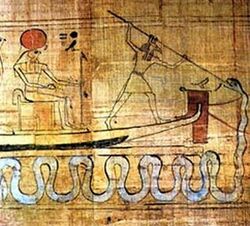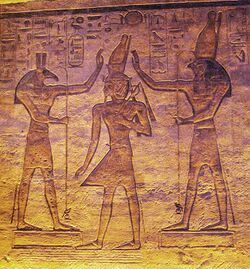Set (deity)
Topic: Religion
 From HandWiki - Reading time: 17 min
From HandWiki - Reading time: 17 min
| Set | |
|---|---|
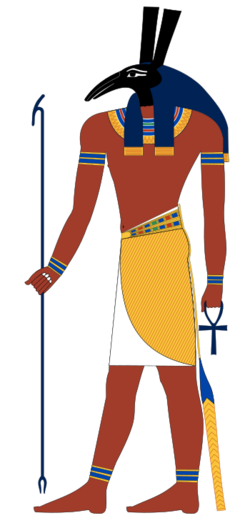 | |
| Major cult center | Ombos, Avaris, Sepermeru |
| Symbol | Was-sceptre, Set animal |
| Personal information | |
| Parents | Geb, Nut |
| Siblings | Osiris, Isis, Nephthys, Horus the Elder |
| Consort | Nephthys, Neith, Anat, and Astarte |
| Offspring | Anubis, Wepwawet,[1] Sobek[2] and Maga[3] |
| Equivalents | |
| Greek equivalent | Typhon |
Set (/sɛt/; Egyptological: Sutekh - swtẖ ~ stẖ[lower-alpha 1] or Greek: Seth /sɛθ/) is a god of deserts, storms, disorder, violence, and foreigners in ancient Egyptian religion.[6]:269 In Ancient Greek, the god's name is given as Sēth (Σήθ). Set had a positive role where he accompanies Ra on his barque to repel Apep, the serpent of Chaos.[6]:269 Set had a vital role as a reconciled combatant.[6]:269 He was lord of the Red Land (desert), where he was the balance to Horus' role as lord of the Black Land (fertile land).[6]:269
In the Osiris myth, the most important Egyptian myth, Set is portrayed as the usurper who murdered and mutilated his own brother, Osiris. Osiris's sister-wife, Isis, reassembled his corpse and resurrected her dead brother-husband with the help of the goddess Nephthys. The resurrection lasted long enough to conceive his son and heir, Horus. Horus sought revenge upon Set and many of the ancient Egyptian myths describe their conflicts.[7]
In ancient Egyptian astronomy, Set was commonly associated with the planet Mercury.[8]
Family
Set is the son of Geb, the Earth, and Nut, the Sky; his siblings are Osiris, Isis, and Nephthys. He married Nephthys and fathered Anubis and Wepwawet.[9] In some accounts, he had relationships with the foreign goddesses Anat and Astarte.[6]:270 From these relationships is said to be born a crocodile deity called Maga.[10]
Name origin
The meaning of the name Set is unknown but it is thought to have been originally pronounced *sūtiẖ [ˈsuw.tixʲ] based on spellings of his name in Egyptian hieroglyphs as stẖ and swtẖ.[11] The Late Egyptian spelling stš reflects the palatalization of ẖ while the eventual loss of the final consonant is recorded in spellings like swtj.[12] The Coptic form of the name, ⲥⲏⲧ Sēt, is the basis for the English vocalization.[11][13]
Set animal
| <hiero>sw-W-t:X-E20-A40</hiero> or <hiero>s-t:S</hiero> or <hiero>z:t:X</hiero> |
style="background: Template:Hiero/Egypt/bgcolour; border-bottom: 1px solid Template:Hiero/Egypt/bordercolour; padding: 0.5em" |
in hieroglyphs |
|---|
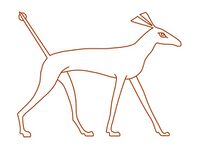
In art, Set is usually depicted as an enigmatic creature referred to by Egyptologists as the Set animal, a beast not identified with any known animal, although it could be seen as a resembling an aardvark, an African wild dog, a donkey, a hyena, a jackal, a pig, an antelope, a giraffe, an okapi, a saluki, or a fennec fox. The animal has a downward curving snout; long ears with squared-off ends; a thin, forked tail with sprouted fur tufts in an inverted arrow shape; and a slender canine body. Sometimes, Set is depicted as a human with the distinctive head. Some early Egyptologists proposed that it was a stylised representation of the giraffe, owing to the large flat-topped "horns" which correspond to a giraffe's ossicones. The Egyptians themselves, however, used distinct depictions for the giraffe and the Set animal. During the Late Period, Set is usually depicted as a donkey or as a man with the head of a donkey,[14] and in the Book of the Faiyum, Set is depicted with a flamingo head.[15]
The earliest representations of what might be the Set animal comes from a tomb dating to the Amratian culture ("Naqada I") of prehistoric Egypt (3790–3500 BCE), although this identification is uncertain. If these are ruled out, then the earliest Set animal appears on a ceremonial macehead of Scorpion II, a ruler of the Naqada III phase. The head and the forked tail of the Set animal are clearly present on the mace.[16]
Conflict of Horus and Set

An important element of Set's mythology was his conflict with his brother or nephew, Horus, for the throne of Egypt. The contest between them is often violent but is also described as a legal judgment before the Ennead, an assembled group of Egyptian deities, to decide who should inherit the kingship. The judge in this trial may be Geb, who, as the father of Osiris and Set, held the throne before they did, or it may be the creator gods Ra or Atum, the originators of kingship.[17] Other deities also take important roles: Thoth frequently acts as a conciliator in the dispute[18] or as an assistant to the divine judge, and in "Contendings", Isis uses her cunning and magical power to aid her son.[19]
The rivalry of Horus and Set is portrayed in two contrasting ways. Both perspectives appear as early as the Pyramid Texts, the earliest source of the myth. In some spells from these texts, Horus is the son of Osiris and nephew of Set, and the murder of Osiris is the major impetus for the conflict. The other tradition depicts Horus and Set as brothers.[20] This incongruity persists in many of the subsequent sources, where the two gods may be called brothers or uncle and nephew at different points in the same text.[21]
The divine struggle involves many episodes. "Contendings" describes the two gods appealing to various other deities to arbitrate the dispute and competing in different types of contests, such as racing in boats or fighting each other in the form of hippopotami, to determine a victor. In this account, Horus repeatedly defeats Set and is supported by most of the other deities.[22] Yet the dispute drags on for eighty years, largely because the judge, the creator god, favors Set.[23] In late ritual texts, the conflict is characterized as a great battle involving the two deities' assembled followers.[24] The strife in the divine realm extends beyond the two combatants. At one point Isis attempts to harpoon Set as he is locked in combat with her son, but she strikes Horus instead, who then cuts off her head in a fit of rage.[25] Thoth replaces Isis's head with that of a cow; the story gives a mythical origin for the cow-horn headdress that Isis commonly wears.[26]
In a key episode in the conflict, Set sexually abuses Horus. Set's violation is partly meant to degrade his rival, but it also involves homosexual desire, in keeping with one of Set's major characteristics, his forceful, potent, and indiscriminate sexuality.[27] In the earliest account of this episode, in a fragmentary Middle Kingdom papyrus, the sexual encounter begins when Set asks to have sex with Horus, who agrees on the condition that Set will give Horus some of his strength.[28] The encounter puts Horus in danger, because in Egyptian tradition semen is a potent and dangerous substance, akin to poison. According to some texts, Set's semen enters Horus's body and makes him ill, but in "Contendings", Horus thwarts Set by catching Set's semen in his hands. Isis retaliates by putting Horus's semen on lettuce-leaves that Set eats. Set's defeat becomes apparent when this semen appears on his forehead as a golden disk. He has been impregnated with his rival's seed and as a result "gives birth" to the disk. In "Contendings", Thoth takes the disk and places it on his own head; in earlier accounts, it is Thoth who is produced by this anomalous birth.[29]
Another important episode concerns mutilations that the combatants inflict upon each other: Horus injures or steals Set's testicles and Set damages or tears out one, or occasionally both, of Horus's eyes. Sometimes the eye is torn into pieces.[30] Set's mutilation signifies a loss of virility and strength.[31] The removal of Horus's eye is even more important, for this stolen eye of Horus represents a wide variety of concepts in Egyptian religion. One of Horus's major roles is as a sky deity, and for this reason his right eye was said to be the sun and his left eye the moon. The theft or destruction of the eye of Horus is therefore equated with the darkening of the moon in the course of its cycle of phases, or during eclipses. Horus may take back his lost Eye, or other deities, including Isis, Thoth, and Hathor, may retrieve or heal it for him.[30] Egyptologist Herman te Velde argues that the tradition about the lost testicles is a late variation on Set's loss of semen to Horus, and that the moon-like disk that emerges from Set's head after his impregnation is the Eye of Horus. If so, the episodes of mutilation and sexual abuse would form a single story, in which Set assaults Horus and loses semen to him, Horus retaliates and impregnates Set, and Set comes into possession of Horus's eye, when it appears on Set's head. Because Thoth is a moon deity in addition to his other functions, it would make sense, according to te Velde, for Thoth to emerge in the form of the Eye and step in to mediate between the feuding deities.[32]
In any case, the restoration of the eye of Horus to wholeness represents the return of the moon to full brightness,[33] the return of the kingship to Horus,[34] and many other aspects of ma'at.[35] Sometimes the restoration of Horus's eye is accompanied by the restoration of Set's testicles, so that both gods are made whole near the conclusion of their feud.[36]
Protector of Ra
Set was depicted standing on the prow of Ra's barge defeating the dark serpent Apep. In some Late Period representations, such as in the Persian Period Temple of Hibis at Khargah, Set was represented in this role with a falcon's head, taking on the guise of Horus. In the Amduat, Set is described as having a key role in overcoming Apep.
Set in the Second Intermediate, Ramesside and later periods
During the Second Intermediate Period (1650–1550 BCE), a group of Near Eastern peoples, known as the Hyksos (literally, "rulers of foreign lands") gained control of Lower Egypt, and ruled the Nile Delta, from Avaris. They chose Set, originally Upper Egypt's chief god, the god of foreigners and the god they found most similar to their own chief god, Hadad, as their patron[citation needed]. Set then became worshiped as the chief god once again. The Hyksos King Apophis is recorded as worshiping Set exclusively, as described in the following passage:[37]
King Apophis chose for his Lord the god Seth. He did not worship any other deity in the whole land except Seth.[lower-alpha 2]
Jan Assmann argues that because the ancient Egyptians could never conceive of a "lonely" god lacking personality, Seth the desert god, who was worshiped on his own, represented a manifestation of evil.[40]
When Ahmose I overthrew the Hyksos and expelled them, in c. 1522 BCE, Egyptians' attitudes towards Asiatic foreigners became xenophobic, and royal propaganda discredited the period of Hyksos rule. The Set cult at Avaris flourished, nevertheless, and the Egyptian garrison of Ahmose stationed there became part of the priesthood of Set.[citation needed]
The founder of the Nineteenth Dynasty, Ramesses I came from a military family from Avaris with strong ties to the priesthood of Set. Several of the Ramesside kings were named after the god, most notably Seti I (literally, "man of Set") and Setnakht (literally, "Set is strong"). In addition, one of the garrisons of Ramesses II held Set as its patron deity, and Ramesses II erected the so-called "Year 400 Stela" at Pi-Ramesses, commemorating the 400th anniversary of the Set cult in the Nile delta.[41]
Set also became associated with foreign gods during the New Kingdom, particularly in the delta. Set was identified by the Egyptians with the Hittite deity Teshub, who, like Set, was a storm god, and the Canaanite deity Baal, being worshipped together as "Seth-Baal".[42]
Additionally, Set is depicted in part of the Greek Magical Papyri, a body of texts forming a grimoire used in Greco-Roman magic during the fourth century CE.[43]
The demonization of Set
According to Herman te Velde, the demonization of Set took place after Egypt's conquest by several foreign nations in the Third Intermediate and Late Periods. Set, who had traditionally been the god of foreigners, thus also became associated with foreign oppressors, including the Kushite and Persian empires.[44] It was during this time that Set was particularly vilified, and his defeat by Horus widely celebrated.
Set's negative aspects were emphasized during this period. Set was the killer of Osiris, having hacked Osiris' body into pieces and dispersed it so that he could not be resurrected. The Greeks would later associate Set with Typhon and Yahweh, a monstrous and evil force of raging nature (being the three of them depicted as donkey-like creatures, classifying their worshippers as onolatrists).[45]
Set and Typhon also had in common that both were sons of deities representing the Earth (Gaia and Geb) who attacked the principal deities (Osiris for Set, Zeus for Typhon).[citation needed] Nevertheless, throughout this period, in some outlying regions of Egypt, Set was still regarded as the heroic chief deity.[citation needed]
Ancient Egyptologist Dr. Kara Cooney shot an episode called "The Birth of the Devil" in the "Out of Egypt" documentary series. In this documentary, the scientist describes the process of demonization of Set and the positioning of the it as absolute evil on the opposite side, in parallel with the transition to monotheism in different regions from Rome to India, where God began to be perceived as the representative of absolute goodness.
Set temples
Set was worshipped at the temples of Ombos (Nubt near Naqada) and Ombos (Nubt near Kom Ombo), at Oxyrhynchus in Upper Egypt, and also in part of the Fayyum area.
More specifically, Set was worshipped in the relatively large metropolitan (yet provincial) locale of Sepermeru, especially during the Ramesside Period.[46] There, Seth was honored with an important temple called the "House of Seth, Lord of Sepermeru". One of the epithets of this town was "gateway to the desert", which fits well with Set's role as a deity of the frontier regions of ancient Egypt. At Sepermeru, Set's temple enclosure included a small secondary shrine called "The House of Seth, Powerful-Is-His-Mighty-Arm", and Ramesses II himself built (or modified) a second land-owning temple for Nephthys, called "The House of Nephthys of Ramesses-Meriamun".[47]
The two temples of Seth and Nephthys in Sepermeru were under separate administration, each with its own holdings and prophets.[48] Moreover, another moderately sized temple of Seth is noted for the nearby town of Pi-Wayna.[47] The close association of Seth temples with temples of Nephthys in key outskirt-towns of this milieu is also reflected in the likelihood that there existed another "House of Seth" and another "House of Nephthys" in the town of Su, at the entrance to the Fayyum.[49]
Papyrus Bologna preserves a most irritable complaint lodged by one Pra'em-hab, Prophet of the "House of Seth" in the now-lost town of Punodjem ("The Sweet Place"). In the text of Papyrus Bologna, the harried Pra'em-hab laments undue taxation for his own temple (The House of Seth) and goes on to lament that he is also saddled with responsibility for: "The ship, and I am likewise also responsible for the House of Nephthys, along with the remaining heap of district temples".[50]
Nothing is known about the particular theologies of the closely connected Set and Nephthys temples in these districts — for example, the religious tone of temples of Nephthys located in such proximity to those of Seth, especially given the seemingly contrary Osirian loyalties of Seth's consort-goddess. When, by the Twentieth Dynasty, the "demonization" of Seth was ostensibly inaugurated, Seth was either eradicated or increasingly pushed to the outskirts, Nephthys flourished as part of the usual Osirian pantheon throughout Egypt, even obtaining a Late Period status as tutelary goddess of her own Nome (UU Nome VII, "Hwt-Sekhem"/Diospolis Parva) and as the chief goddess of the Mansion of the Sistrum in that district.[51][52][53][54]
Seth's cult persisted even into the latter days of ancient Egyptian religion, in outlying but important places like Kharga, Dakhlah, Deir el-Hagar, Mut, and Kellis. In these places, Seth was considered "Lord of the Oasis / Town" and Nephthys was likewise venerated as "Mistress of the Oasis" at Seth's side, in his temples[55] (esp. the dedication of a Nephthys-cult statue). Meanwhile, Nephthys was also venerated as "Mistress" in the Osirian temples of these districts as part of the specifically Osirian college.[55] It would appear that the ancient Egyptians in these locales had little problem with the paradoxical dualities inherent in venerating Seth and Nephthys, as juxtaposed against Osiris, Isis, and Nephthys.
In modern religion
In popular culture
In the manga and anime series JoJo's Bizarre Adventure: Stardust Crusaders, a minor enemy named Alessi has a Stand based on Set, with the ability to reflect Alessi's shadow, including items he holds, and can rapidly de-age whoever steps into his shadow.[56]
In the 13th season Doctor Who serial Pyramids of Mars, Set (using the name Sutekh) is portrayed as an alien entity. Imprisoned under an Egyptian pyramid millennia ago by Horus, he is bent on destroying all life if he is ever freed.
In the role-playing game Vampire: The Masquerade, the ancient Egyptian deity Set is depicted as an antediluvian vampire, believed to be one of the oldest undead beings. Revered as the founder of the enigmatic Followers of Set (now known as The Ministry in the game's fifth edition). Imprisoned in torpor, Set remains a focal point for his followers who strive to rouse him from his slumber. He commands powers entwined with manipulation, darkness, and serpentine subtlety, epitomized by his unique Discipline, Serpentis, dedicated to the mastery of serpents.
In the Shin Megami Tensei series, Set (using the name Seth) is portrayed as a black dragon throughout multiple of the installments.
In the 1992 Nintendo Entertainment System video game titled "Nightshade", the villain's public personal is that of "Sutekh", a criminal underboss who unifies the gangs of the fictitious Metro City. In line with the idea of Sutekh, of Egyptian mythology, the Sutekh in the video game reigns supreme over all of the violence in the city. Of particular note, in Egyptian mythology, Sutekh is also the god of foreigners. In the Nightshade video game, its villain is not of Egyptian descent, but instead a man by the name of Waldo P. Schmeer who is a historian obsessed with Egyptian lore.
In SMITE, Set is a playable assassin, released alongside his rival nephew Horus.
In the BL manhwa ENNEAD, written and illustrated by Mojito, Set (using the name Seth) is the main character. It draws heavily upon classic Egyptian mythology and centers on the conflict between Horus and Seth.
Ahead of the release of their 25th studio album, The Silver Cord (King Gizzard & the Lizard Wizard album), Australian band King Gizzard & the Lizard Wizard released the album's first three songs.[57] The third of these, titled "Set", describes Set killing Osiris and his subsequent conflict with Horus.
See also
- Horea (mythology)
- Set animal
Notes
- ↑ Also transliterated Sheth, Setesh, Sutekh, Seteh, Setekh, or Suty. Sutekh appears, in fact, as a god of Hittites in the treaty declarations between the Hittite kings and Ramses II after the battle of Qadesh. Probably Seteh is the lection (reading) of a god honoured by the Hittites, the "Kheta", afterward assimilated to the local Afro-Asiatic Seth.[4][5]
- ↑ Translation from Assmann 2008, p. 48. Goedicke's translation: "And then King Apophis, l.p.h., was appointing for himself Sutekh as Lord. He never worked for any other god which is in this entire country except Sutekh.[38] Goldwasser's translation: "Then, king Apophis l.p.h. adopted for himself Seth as lord, and he refused to serve any god that was in the entire land except Seth."[39]
References
- ↑ "Set" (in en). https://mythopedia.com/topics/set.
- ↑ "Sobek from Ancient Egypt". http://www.museumofmythology.com/Egypt/sobek.htm.
- ↑ Ritner, Robert K. (1984). "A uterine amulet in the Oriental Institute collection". Journal of Near Eastern Studies 43 (3): 209–221. doi:10.1086/373080. PMID 16468192.
- ↑ Cite error: Invalid
<ref>tag; no text was provided for refs namedSayce-nd-Hittites - ↑ Cite error: Invalid
<ref>tag; no text was provided for refs namedBudge-nd-HstEgy - ↑ 6.0 6.1 6.2 6.3 6.4 Herman Te Velde (2001). "Oxford Encyclopedia of Ancient Egypt". Oxford Encyclopedia of Ancient Egypt. 3.
- ↑ Strudwick, Helen (2006). The Encyclopedia of Ancient Egypt. New York: Sterling Publishing Co., Inc.. pp. 124–125. ISBN 978-1-4351-4654-9.
- ↑ Parker, R.A. (1974). "Ancient Egyptian astronomy". Philosophical Transactions of the Royal Society of London. A, Mathematical and Physical Sciences 276 (1257): 51–65. doi:10.1098/rsta.1974.0009. Bibcode: 1974RSPTA.276...51P.
- ↑ "Set" (in en). https://mythopedia.com/topics/set.
- ↑ Rogers, John (2019). "The demon-deity Maga: geographical variation and chronological transformation in ancient Egyptian demonology". Current Research in Egyptology 2019: 183–203. https://www.academia.edu/46879153.
- ↑ 11.0 11.1 te Velde 1967, pp. 1–7.
- ↑ "Thesaurus Linguae Aegyptiae". https://aaew.bbaw.de/tla/servlet/S05?d=d001.
- ↑ "Coptic Dictionary Online". https://corpling.uis.georgetown.edu/coptic-dictionary/entry.cgi?entry=2733&super=1095.
- ↑ te Velde 1967, pp. 13–15.
- ↑ Beinlich, Horst (2013). The Book of the Faiyum. University of Heidelberg. pp. 27–77, esp.38–39. https://archiv.ub.uni-heidelberg.de/propylaeumdok/2891/1/Beinlich_Faiyum_2013.pdf.
- ↑ te Velde 1967, pp. 7–12.
- ↑ Griffiths 1960, pp. 58–59
- ↑ Griffiths 1960, p. 82
- ↑ Assmann 2001, pp. 135, 139–140
- ↑ Griffiths 1960, pp. 12–16
- ↑ Assmann 2001, pp. 134–135
- ↑ Lichtheim 2006b, pp. 214–223
- ↑ Hart 2005, p. 73
- ↑ Pinch 2004, p. 83
- ↑ Lichtheim 2006b, pp. 218–219
- ↑ Griffiths 2001, pp. 188–190.
- ↑ te Velde 1967, pp. 55–56, 65
- ↑ Griffiths 1960, p. 42
- ↑ te Velde 1967, pp. 38–39, 43–44
- ↑ 30.0 30.1 Pinch 2004, pp. 82–83, 91
- ↑ te Velde 1967, pp. 42–43
- ↑ te Velde 1967, pp. 43–46, 58
- ↑ Kaper 2001, pp. 480–482.
- ↑ Griffiths 1960, p. 29
- ↑ Pinch 2004, p. 131
- ↑ te Velde 1967, pp. 56–57
- ↑ Assmann 2008, pp. 48, 151 n. 25, citing: Goedicke 1986, pp. 10–11 and Goldwasser 2006.
- ↑ Goedicke 1986, p. 31.
- ↑ Goldwasser 2006, p. 129.
- ↑ Assmann 2008, pp. 47–48.
- ↑ Nielsen, Nicky. "The Rise of the Ramessides: How a Military Family from the Nile Delta Founded One of Egypt's Most Celebrated Dynasties". https://www.arce.org/resource/rise-ramessides-how-military-family-nile-delta-founded-one-egypts-most-celebrated.
- ↑ Keel, Othmar; Uehlinger, Christoph (1998-01-01) (in en). Gods, Goddesses, And Images of God. Bloomsbury Academic. ISBN 978-0-567-08591-7. https://books.google.com/books?id=NjYAWXO-jdAC&dq=Seth-Baal&pg=PA114.
- ↑ Set in Roman Magical Papyrus
- ↑ te Velde 1967, pp. 138–140.
- ↑ Litwa, M. David (2021). "The Donkey Deity". The Evil Creator: Origins of an Early Christian Idea. New York, NY: Oxford University Press. ISBN 978-0-19-756643-5. OCLC 1243261365. https://www.worldcat.org/oclc/1243261365. "We see this tradition recounted by several writers. Around 200 BCE, a man called Mnaseas (an Alexandrian originally from what is now southern Turkey), told a story of an Idumean (southern Palestinian) who entered the Judean temple and tore off the golden head of a pack ass from the inner sanctuary. This head was evidently attached to a body, whether human or donkey. The reader would have understood that the Jews (secretly) worshiped Yahweh as a donkey in the Jerusalem temple, since gold was characteristically used for cult statues of gods. Egyptians knew only one other deity in ass-like form: Seth."
- ↑ Sauneron. Priests of Ancient Egypt. p. 181.[full citation needed]
- ↑ 47.0 47.1 Katary 1989, p. 216.
- ↑ Katary 1989, p. 220.
- ↑ Gardiner, ed. Papyrus Wilbour Commentary. S28. pp. 127–128.[full citation needed]
- ↑ Papyrus Bologna 1094, 5,8–7, 1 [full citation needed]
- ↑ Sauneron, Beitrage Bf. 6, 46 [full citation needed]
- ↑ Pantalacci, L.; Traunecker, C. (1990). Le temple d'El-Qal'a. Relevés des scènes et des textes. I' Sanctuaire central. Sanctuaire nord. Salle des offrandes 1 à 112 (Report). Cairo, Egypt: Institut Français d'Archéologie Orientale.
- ↑ Wilson, P. (1997). A Ptolemaic Lexicon: A lexicographical study of the texts in the Temple of Edfu. OLA 78. Leuven. ISBN 978-90-6831-933-0.
- ↑ Collombert, P. (1997). "Hout-sekhem et le septième nome de Haute Égypte II: Les stèles tardives (Pl. I–VII)". Revue d'Égyptologie 48: 15–70. doi:10.2143/RE.48.0.2003683.
- ↑ 55.0 55.1 Kaper 1997b, pp. 234–237.
- ↑ Araki, Hirohiko (1991-07-10) (in en). JoJo's Bizarre Adventure. Shueisha. ISBN 4-08-851565-X. http://www.shueisha.co.jp/books/items/contents.html?isbn=4-08-851565-X.
- ↑ Rettig, James (2023-10-03). "King Gizzard & The Lizard Wizard – "Theia / The Silver Cord / Set"". https://www.stereogum.com/2237851/king-gizzard-the-lizard-wizard-theia-the-silver-cord-set/music/.
Sources
- Allen, James P. (2004). "Theology, theodicy, philosophy: Egypt". in Johnston, Sarah Iles. Religions of the Ancient World: A guide. Cambridge, Massachusetts: Harvard University Press. ISBN 978-0-674-01517-3.
- Assmann, Jan (2001). The Search for God in Ancient Egypt. Translated by David Lorton. Cornell University Press. ISBN 978-0-8014-3786-1. https://archive.org/details/searchforgodinan00assm.
- Assmann, Jan (2008). Of God and Gods: Egypt, Israel, and the rise of monotheism. University of Wisconsin Press. ISBN 978-0-299-22550-6.
- Bickel, Susanne (2004). "Myths and sacred narratives: Egypt". in Johnston, Sarah Iles. Religions of the Ancient World: A guide. Cambridge, Massachusetts: Harvard University Press. ISBN 978-0-674-01517-3.
- Cohn, Norman (1999). Cosmos, Chaos and the World to Come: The ancient roots of apocalyptic faith (paperback reprint ed.). New Haven, CT: Yale University Press. ISBN 978-0-300-09088-8.
- Gardiner, Alan H., ed (1932). "The Quarrel of Apophis and Seḳnentēr". Late-Egyptian Stories. Bibliotheca Aegptiaca. I. Bruxelles: Fondation Egyptologique Reine Elisabeth. p. 85. https://archive.org/details/GardinerLateEgyptianStoriesPdf/page/n185/mode/1up.
- Goedicke, Hans (1986). The Quarrel of Apophis and Seqenenrec. San Antonio: Van Siclen. ISBN 0-933175-06-X.
- Goldwasser, Orly (2006). "King Apophis of Avaris and the Emergence of Monotheism". in Czerny, Ernst; Hein, Irmgard; Hunger, Hermann et al.. Timelines: Studies in Honour of Manfred Bietak. Orientalia Lovaniensia Analecta. 149/II. Leuven: Peeters. pp. 129–133. ISBN 978-90-429-1730-9.
- Griffiths, J. Gwyn (1960). The Conflict of Horus and Seth. Liverpool University Press.
- Griffiths, J. Gwyn (2001). "Osiris". in Redford, Donald B.. The Oxford Encyclopedia of Ancient Egypt. 2. Oxford University Press. pp. 615–619. ISBN 978-0-19-510234-5.
- Hart, George (2005). The Routledge Dictionary of Egyptian Gods and Goddesses, Second Edition. Routledge. ISBN 978-0-203-02362-4.
- Ions, Veronica (1982). Egyptian Mythology. New York, NY: Peter Bedrick Books. ISBN 978-0-87226-249-2. https://archive.org/details/egyptianmytholog00vero_0.
- Kaper, Olaf Ernst (1997a). Temples and Gods in Roman Dakhlah: Studies in the indigenous cults of an Egyptian oasis. Faculteit der Letteren (doctoral dissertation). Groningen, DE: Rijksuniversiteit Groningen.
- Kaper, Olaf E. (2001). "Myths: Lunar Cycle". in Redford, Donald B.. The Oxford Encyclopedia of Ancient Egypt. 2. Oxford University Press. pp. 480–482. ISBN 978-0-19-510234-5.
- Kaper, Olaf Ernst (1997b). "The Statue of Penbast: On the cult of Seth in the Dakhlah oasis". in van Dijk, Jacobus. Essays on Ancient Egypt in Honour of Herman te Velde. Egyptological Memoirs. 1. Groningen, DE: Styx Publications. pp. 231–241. ISBN 978-90-5693-014-1. https://books.google.com/books?id=dv_2slpteq4C&pg=PA231.
- Katary, Sally L.D. (1989). Land Tenure in the Rammesside Period. Kegan Paul International.
- Lesko, Leonard H. (2005). "Seth". in Jones, Lindsay. The Encyclopedia of Religion. [edited 1987 by Mircea Eliade] (2nd ed.). Farmington Hills, Michigan: Thomson-Gale. ISBN 978-0-02-865733-2. https://archive.org/details/encyclopediaofre0000unse_v8f2.
- Lichtheim, Miriam (2006b). Ancient Egyptian Literature, Volume II: The New Kingdom. University of California Press. ISBN 978-0-520-24843-4.
- Osing, Jürgen (1985). Seth in Dachla und Charga (Report). Mitteilungen des Deutschen Archäologischen Instituts. 41. Deutschen Archäologischen Instituts. pp. 229–233.
- Pinch, Geraldine (2004). Egyptian Mythology: A Guide to the Gods, Goddesses, and Traditions of Ancient Egypt. Oxford University Press. ISBN 978-0-19-517024-5.
- Quirke, Stephen G.J. (1992). Ancient Egyptian Religion (reprint ed.). New York, NY: Dover Publications. ISBN 978-0-486-27427-0.
- Stoyanov, Yuri (2000). The Other God: Dualist religions from antiquity to the Cathar heresy. New Haven, CT: Yale University Press. ISBN 978-0-300-08253-1.
- te Velde, Herman (1967). Seth, God of Confusion: A study of his role in Egyptian mythology and religion. Probleme der Ägyptologie. 6 (2nd ed.). Leiden, NL: E.J. Brill. ISBN 978-90-04-05402-8.
External links
- "Le temple d'Hibis, oasis de Khargha". http://alain.guilleux.free.fr/khargha_hibis/khargha_temple_hibis.html. – representations of Sutekh as Horus
 |
60 views | Status: cached on July 18 2024 16:18:19
↧ Download this article as ZWI file
 KSF
KSF
